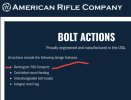I had a conversation with someone who fireforms a lot a brass into AI. He pointed out to me that AI fireformed brass is being stretched .080 to .100" upon fireforming and the cases don't kaboom ever. That is by orders of magnitude more than I could ever possible cause a kaboom from .003".
,002 bump has become the standard.
.004 bump is what Alex Wheeler likes
AI fire-formed brass with the case head held in contact with the bolt face (as in crush fit upon bolt closure) is blown forward in the shoulder area, where the case brass has been annealed, is thin, and malleable. Your ~0.003" gap between case shoulder and chamber shoulder is insignificant. Not a cause for this separation at the extractor groove.
On the other hand, I think no casing at the extractor groove, or in the location ~0.200" forward from the case head (where case heads typically separate) can be "stretched" 0.080" to 0.100" without separation failure. The case web brass isn't annealed, and isn't very malleable. It can stretch smaller amounts prior to separation. Not 0.080" - 0.100".
Good cases in properly chambered bolt actions only blow out where your's did under excessively high pressure.
BUT... that casing certainly could have been manufactured with a defect which compromised it's pressure containing strength. Causing it to rupture at normal cartridge pressures.
As someone else already suggested... I'd throw away the rest of that Lot of suspect Lapua casings. I'd also contact Lapua. Share your incident and pictures. Send them the ruptured casing, if they expressed the interest in running some laboratory tests. Since you didn't suffer any permanent debilitating injuries.
Last edited:



